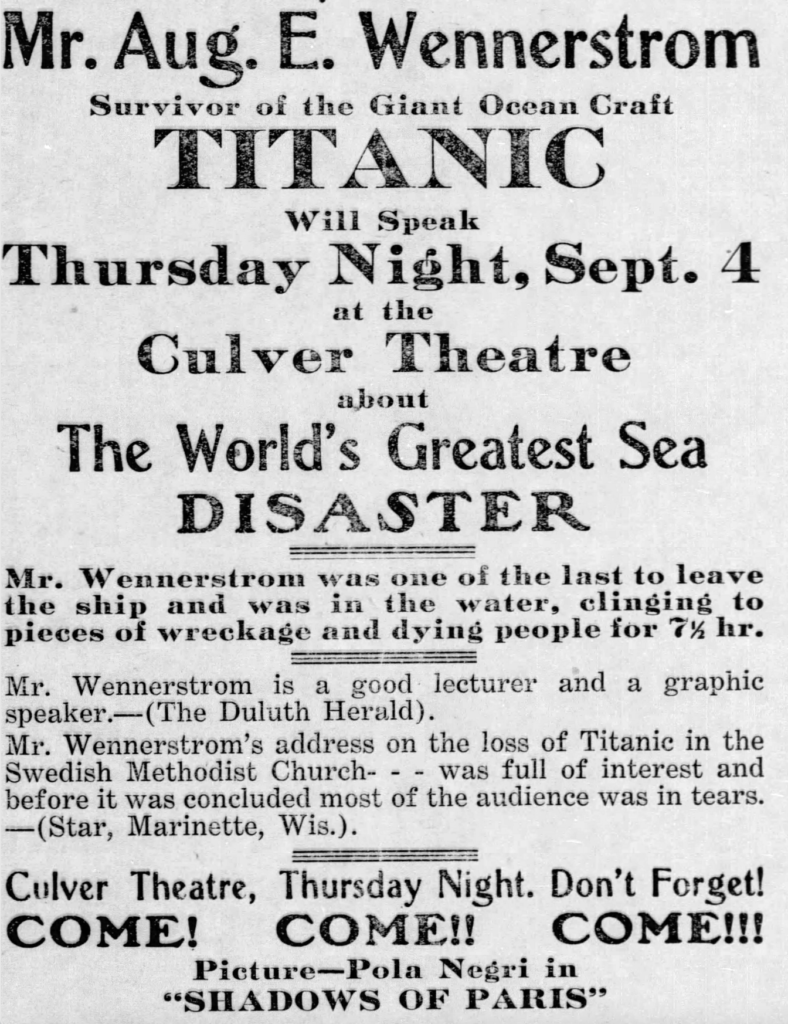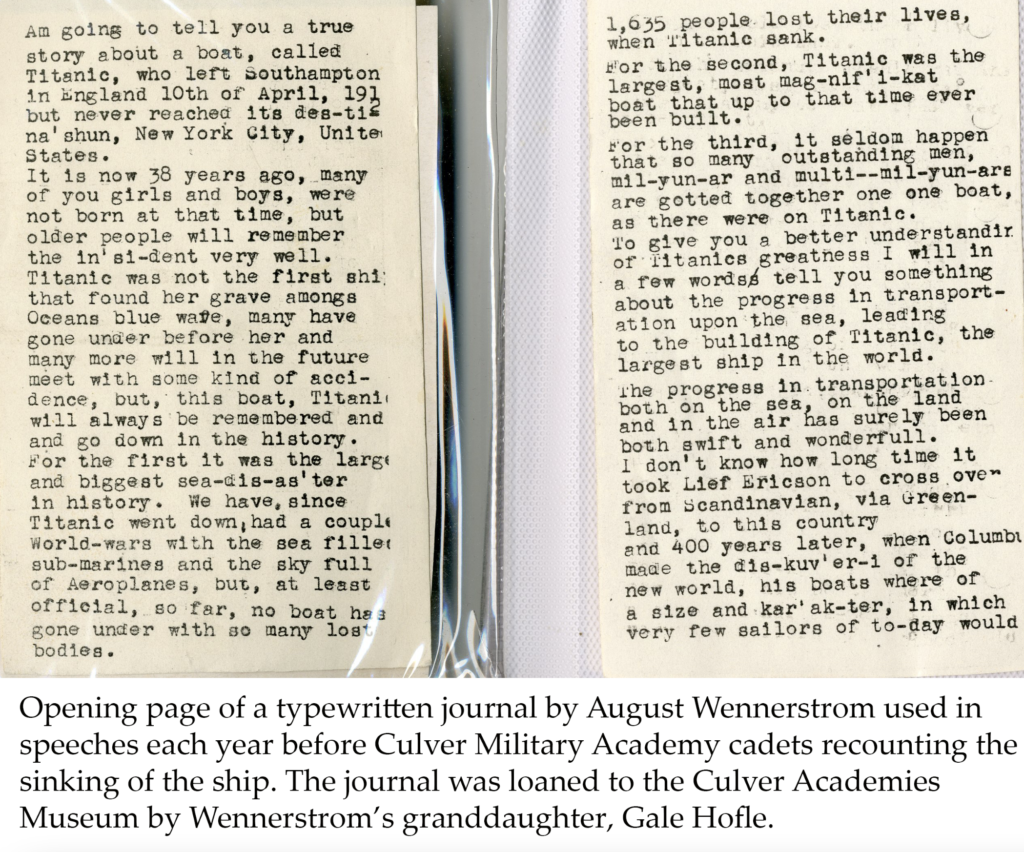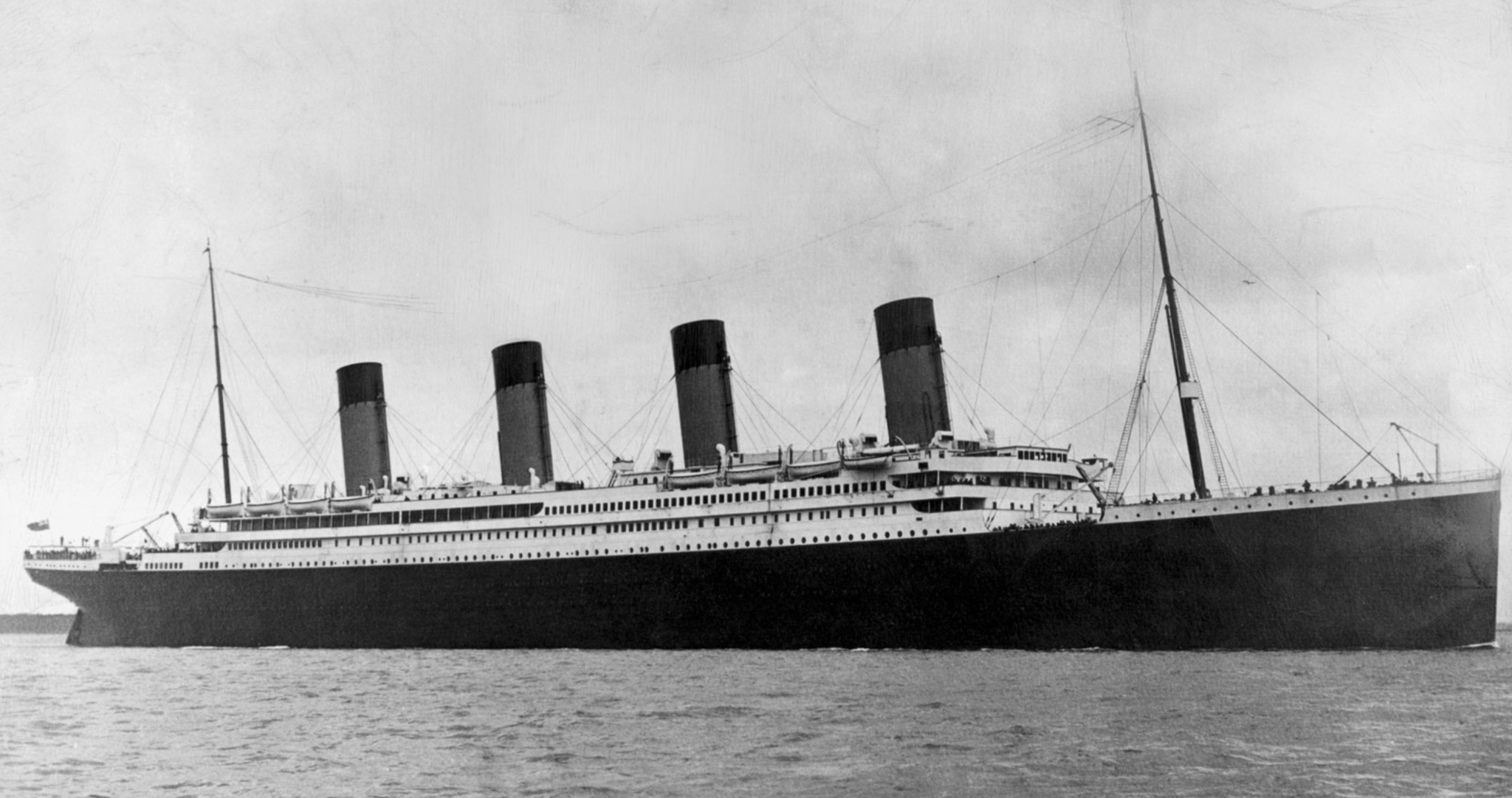Local Connections to the Titanic Still Visible in the Lakes Area
Writer / Jeff Kenney
Photography Provided by the Culver Academies archives, Antiquarian and Historical Society of Culver, and public domain.
This month marks the 110th anniversary, from April 15, 1912, of arguably the most infamous and enduringly gripping disaster in modern history – when the RMS Titanic ship sank to the bottom of the sea. While the lore surrounding the event, right down to the award-winning 1997 movie about it, may be worldwide in scope, there’s a very local connection.
August “Leo” Wennerström, superintendent of buildings and grounds at Culver Military Academy, annually recounted in harrowing detail his escape from that ship, and eventually his journey to become one of the only survivors of its sinking to relocate to Indiana.
While on the Titanic, August Edvard Andersson, a young Swedish journalist and publisher traveling under the pseudonym “Wennerström,” had met several other Swedes who were emigrating or returning to the U.S. including Alma Pålsson and her four children, who were on their way to Chicago to rejoin their husband and father, Nils.

As the ship began to sink, some lifeboats were deliberately launched partly empty so that they could row back for survivors, which eventually inadvertently saved Wennerström.
Wennerström later wrote of the sinking, “Cry, cry everywhere. Prayer and more prayer. Not very often has God been remembered and called on as he was in that night.”
As the ship sank, Wennerström first tried to rescue two of the Pålsson children, but lost hold of them. Alma Pålsson’s body was recovered and she was buried in Halifax, Nova Scotia, on May 8, 1912, though her children were never found.
Wennerström would later recall floating for some time and awakening on top of three bodies floating in the water. He made it to a collapsible boat, later noting that all feeling had left his legs in the frigid cold, and that occasionally the bodies of those who had died were cast off the boat to lighten its weight.
After the Carpathia ship delivered survivors to New York City, Wennerström eventually made his way to Chicago where he met and eventually married Naomi Johnson.
Wennerström’s journey to Culver was an odd one, and his motives for being at the train station in Culver when he was were never completely clear, but his timing was fortuitous. Culver Military Academy was expecting the arrival of a new gardener named Leo, to work for the school’s grounds department, and Wennerström was assumed to be that gardener, who never showed up. So, by 1913, August Wennerström found himself with gainful employment and a nickname he would keep for the rest of his life – Leo.
August and Naomi had one daughter and six sons, including one whose first name reflected the couple’s appreciation and love of their adopted community – Culver Wennerström (the Swedish punctuation was also eventually dropped from their last name, at least in print locally). All of the Wennerströms served their country in World War II.

August Wennerström held the position of head groundskeeper at the academy until his retirement in 1941. He also frequently spoke at the academy and in venues around the region and the country, particularly Swedish Methodist churches, about his experience on the Titanic.
Another Culver-area link to the Titanic developed in relation to Wennerström. In 1946, Nils Pålsson (whose name by then had been Anglicized to Paulson) finally remarried and retired to Culver after connecting with Wennerström, who related his sad tale of attempting to save Paulson’s wife and children.
Paulson and his wife Christina lived on William Street in the town of Culver, but he owned a garden plot on Thorn Road, next to the home of Allen and Rosemary Weaver, where he tearfully planted four maple seedlings taken from trees on William Street, apparently in memory of the four children he had lost decades before.
August Wennerström died in 1950 and Nils Paulson in 1964, and both are buried in the Culver Masonic Cemetery. Their graves, and the trees (which are still visible at roadside) remain visible testimony to one of the great tragedies of recent centuries.
(Author’s note: Allen and Rosemary Weaver’s son Dan Weaver tells the story of August Wennerström, Nils Paulson, and watching the planting of the “Titanic Trees,” in the 2018 PBS documentary, “Our Town: Culver,” viewable online at facebook.com/wnitpublictv/videos/240701283255989).
Author Jeff Kenney is museum and archives manager at Culver Academies and serves on the board of the Antiquarian and Historical Society of Culver.







Comments 1
I would like to see a copy of Wennerstrom’s lecture in the Titanic. My great great uncle was Nils Paulson. It was his children on the Titanic that Wennerstrom supposedly was trying to save. I have never been able to find a copy of his lecture on the Titanic disaster.